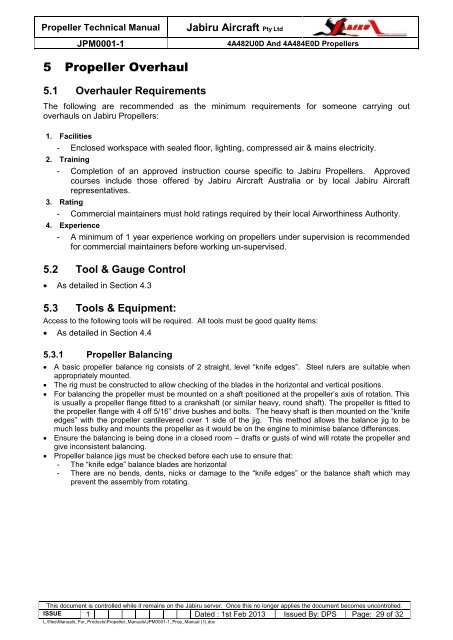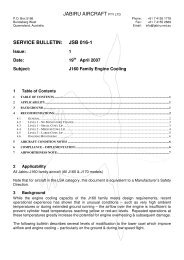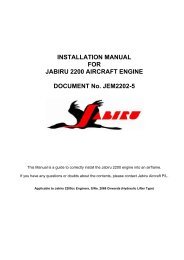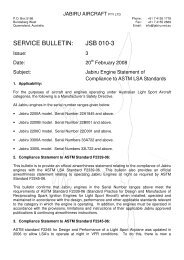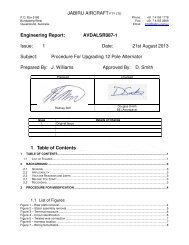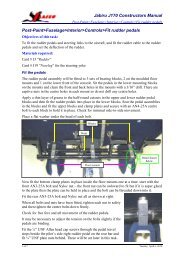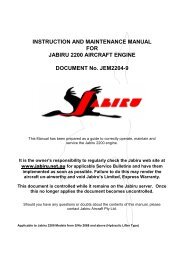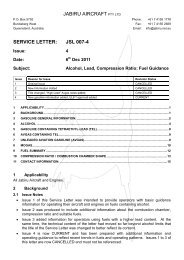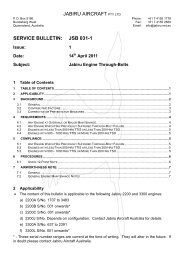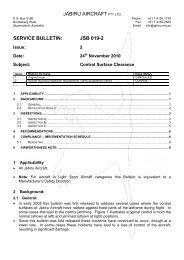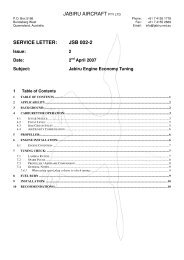Propeller Technical Manual - Jabiru
Propeller Technical Manual - Jabiru
Propeller Technical Manual - Jabiru
Create successful ePaper yourself
Turn your PDF publications into a flip-book with our unique Google optimized e-Paper software.
<strong>Propeller</strong> <strong>Technical</strong> <strong>Manual</strong><br />
JPM0001-1<br />
<strong>Jabiru</strong> Aircraft Pty Ltd<br />
4A482U0D And 4A484E0D <strong>Propeller</strong>s<br />
5 <strong>Propeller</strong> Overhaul<br />
5.1 Overhauler Requirements<br />
The following are recommended as the minimum requirements for someone carrying out<br />
overhauls on <strong>Jabiru</strong> <strong>Propeller</strong>s:<br />
1. Facilities<br />
- Enclosed workspace with sealed floor, lighting, compressed air & mains electricity.<br />
2. Training<br />
- Completion of an approved instruction course specific to <strong>Jabiru</strong> <strong>Propeller</strong>s. Approved<br />
courses include those offered by <strong>Jabiru</strong> Aircraft Australia or by local <strong>Jabiru</strong> Aircraft<br />
representatives.<br />
3. Rating<br />
- Commercial maintainers must hold ratings required by their local Airworthiness Authority.<br />
4. Experience<br />
- A minimum of 1 year experience working on propellers under supervision is recommended<br />
for commercial maintainers before working un-supervised.<br />
5.2 Tool & Gauge Control<br />
As detailed in Section 4.3<br />
5.3 Tools & Equipment:<br />
Access to the following tools will be required. All tools must be good quality items:<br />
As detailed in Section 4.4<br />
5.3.1 <strong>Propeller</strong> Balancing<br />
A basic propeller balance rig consists of 2 straight, level “knife edges”. Steel rulers are suitable when<br />
appropriately mounted.<br />
The rig must be constructed to allow checking of the blades in the horizontal and vertical positions.<br />
For balancing the propeller must be mounted on a shaft positioned at the propeller’s axis of rotation. This<br />
is usually a propeller flange fitted to a crankshaft (or similar heavy, round shaft). The propeller is fitted to<br />
the propeller flange with 4 off 5/16” drive bushes and bolts. The heavy shaft is then mounted on the “knife<br />
edges” with the propeller cantilevered over 1 side of the jig. This method allows the balance jig to be<br />
much less bulky and mounts the propeller as it would be on the engine to minimise balance differences.<br />
Ensure the balancing is being done in a closed room – drafts or gusts of wind will rotate the propeller and<br />
give inconsistent balancing.<br />
<strong>Propeller</strong> balance jigs must be checked before each use to ensure that:<br />
- The “knife edge” balance blades are horizontal<br />
- There are no bends, dents, nicks or damage to the “knife edges” or the balance shaft which may<br />
prevent the assembly from rotating.<br />
This document is controlled while it remains on the <strong>Jabiru</strong> server. Once this no longer applies the document becomes uncontrolled.<br />
ISSUE 1 Dated : 1st Feb 2013 Issued By: DPS Page: 29 of 32<br />
L:\files\<strong>Manual</strong>s_For_Products\<strong>Propeller</strong>_<strong>Manual</strong>s\JPM0001-1_Prop_<strong>Manual</strong> (1).doc


